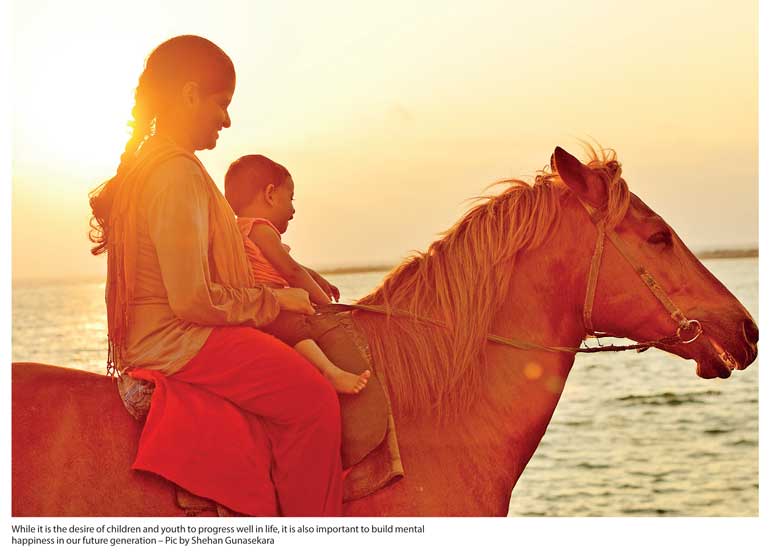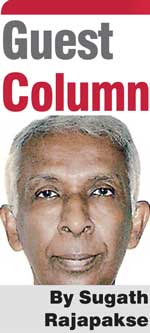Thursday Dec 04, 2025
Thursday Dec 04, 2025
Friday, 12 January 2018 00:00 - - {{hitsCtrl.values.hits}}

 In the marketing fraternity, in order to gain access to consumers, the various products and services on offer use various strategies and one such thing is the USP (Unique Selling Proposition). In short USP is all about what you think is unique in your product, be it FMCG, consumer durables or services.
In the marketing fraternity, in order to gain access to consumers, the various products and services on offer use various strategies and one such thing is the USP (Unique Selling Proposition). In short USP is all about what you think is unique in your product, be it FMCG, consumer durables or services.
In the service industry both the airline and hospitality industry work hard on this promise. Thus in airlines some may talk of inflight service, while others about punctuality and still others about the amenities such as IFE (inflight entertainment) or flat beds, exclusive family apartment, etc. Then still there are others who are talking of Wi-Fi and soon to be introduced Artificial Intelligence (AI), etc.
Hospitality industry players too do a lot to differentiate themselves from each other even if in the same star category. In the last 20 to 25 years many new concepts with USP has emerged such as boutique hotels, eco hotels, resort hotels, etc. But all of these propositions are about self, expecting the consumer to buy the products. If the consumers’ expectation does not rhyme with the USP then you may find price dilutions even at times lower than the EMSR (Expected Marginal Seat Revenue) metrics in airlines or the RevPAR metrics in hospitality industry.
UBP works on a different platform. UBP will apply to everything including even manufacturing where ‘whose widgets are optimal?’ or ‘which software is the best?’ and ‘which meta search engine can do my work?’ is decided by the buyer. It applies to the service industry, consumer products as well as social media, chat, messaging, etc. It also applies to individuals such as politicians or others like doctors or lawyers. ‘Should I vote for that politician or go to this doctor or lawyer?’ It is all a buyers’ decision.
Who are the buyers? Be it a company purchasing or an individual or group of individuals, they are in the end human beings. Today people especially the mass consumer does not make purchases purely on needs but often on an impulse as well. This applies mostly to personal care items and apparel. That is why today there is often two to three dress cupboards per person whereas 40 to 50 years ago a family of five to six would have had only one almirah. On a dressing table one may find multitude of skin care products, hair care products, etc. So it is with shoes as well as most other personal things. This also applies to other things such as furniture, home décor and even motor vehicles.
Then when it comes to food it is even more complex. There is today a plethora of food products, liquids, solids, semi-solids of so many verities, and with the range increasing all the time. So, why this sudden explosion in buying habits?
The sudden explosion is mainly due to UBP and not USP. Therefore, it is necessary to understand what UBP is because USP is increasingly losing significance due given many similarities in services and products, despite the various claims of the producers.
The UBP is built upon the illustrations of name-form (nama-rupa) that illustrate the consciousness. These illustrations could be negative ones or positive ones. In the marketing field what surfaces are mainly the negative ones of greed and desires. Nama is of feelings, perceptions, volitions, contact and contemplation while rupa is that of form-perception. It is these name-form perceptions that are the key to the success of social media, messaging apps, chat and digital marketing contents, etc.
In social media the consumers are able to surf it for hours at leisure seeking things that conform with their illustrations in the consciousness. Being aware of the illustrations in their consciousness, people seek integration with others who too would be having such illustrations. Thus those with hatred rhymes with those having hatred but dormant at the moment. Same is true of those with compassion and loving-kindness influencing those having same traits in dormant state. The illustrations are threefold:
Illustrations that are either bubbling inside or have surfaced will determine the UBP in the present moment. Yet due to an external stimulus dormant illustrations can quickly emerge and this in marketing is termed impulsive buying. This impulsive buying can be caused by an advertisement, a statement of a brand ambassador or a special promotion due to seasonal reasons, false claims, falsification of facts such as creating a scarcity, etc.
In the brands and branding environment most brands make use of brand ambassadors. These people are often said to be iconic and will use their influence on others to promote the brands. The word brand came from an Old Norse word brandr, meaning to burn. The British people took this word and to identify their cattle, using letters (often first letter in the surname) burned the skin of the cattle which would indicate who the owner is and termed it branding. Thus in essence, what the brand ambassadors are doing is burning the consciousness of consumers.
In all these cases of advertising, brand ambassadors, false claims, falsification of facts such as creating a scarcity causes the consumer to stimulate the inert greed or hatred. Such actions will have extreme negative impacts for the responsible people who caused to illustrate others consciousness because name-rupa is the forerunner to mind.
UBP is constantly evolving, driven by the plethora of external stimuli that are bombarding the six touch-agencies. The touch-agencies arise all the time, a form that comes to the view of the eye there arise eye-consciousness and the going together of eye, eye-consciousness and form-perception leads to touch. So the whole time in mundane people there is assimilation and these name-form illustrations assimilated influence the evolution of the UBP.
It is here that we see the dangers in indulgence of social media, various software that are creating an artificial world of such things as games by the people. Continuous illustration of such negatives will illustrate the consciousness negatively. UBP is thus not restricted to only the purchase of goods and services but the negative reactions of the humans as well.
Some recent examples are the mass shootings at a Las Vegas Music festival killing 59 people, and the Texas Church shooting. In fact, this year 2018 up to 2nd January there had been 211-gun violence incidents in USA resulting in 70 deaths. In New Delhi India a teenager last December killed his mother and sister, and as per Police he was addicted to a video game “Gangster in High School” that dares players to kill and get away with it.
Thus the media, the social, electronic, messaging, chat, video games and even the print need to see the gravity and not try to illustrate the consciousness of humans negatively with their airing of the content that are harmful to society at large.
In Sri Lanka the UBP especially of children is in a state of flux. Peer pressure due to expectation of parents and others to perform better than others in education has driven great majority of children to the tuition support system. This value addition in education outside the usual school time and even on the weekends and holidays is taking its toll on children’s mental strengths.
TIME in an article by Siobhan O’connor in September 2017 states, “Peter Gray, the author of that article and a psychology professor emeritus at Boston College, says the decline in free play is “at least partly because adults have exerted ever-increasing control over children’s activities,” which should sound familiar to many parents. As even elementary schools come under greater and greater pressure to have their students score well on standardised tests, recess time has been increasingly cut. In 1989, 96% of elementary schools had at least one recess period, yet just a decade later, one survey found that only 70% of even kindergarten classrooms had any recess periods at all.
Gray and other play experts believe these changes have had lasting and negative effects on children. He notes that over the same years that recess and playtime have declined, there have been rises in major depression, anxiety and the suicide rate. “If we love our children and want them to thrive, we must allow them more time and opportunity to play, not less,” Gray has written (http://time.com/4928925/secret-power-play/).
Even in countries like Australia depression and anxiety is having a negative impact on children and teens. According to a recent article in www.huffingtonpost.com.au, more Australian teenagers are in severe psychological distress than five years ago despite growing awareness and initiatives aimed at tackling mental illness, a new report shows.
The alarming statistics, released in a report by Mission Australia in 2017 show almost a quarter of teens surveyed meet the criteria for probable serious mental illness, with girls twice as likely as boys to be affected.
The present-day tuition structure in Sri Lanka does not allow children to have much free time, and must be causing lots of mental health damage. To have a nation that is free from the danger of drug addiction, it is important for children to have balanced minds. Anxiety and mental stress only drive kids to seek alternate stress release avenues and could thus to exposed to machinations of drug peddlers.
An article in December 2017 edition.cnn.com speaks on the gravity of smart phone addiction and how it impacts us.
“You may be one of the growing number of Americans (or global citizens) who has a bit of nomophobia. “Nomophobia?” you mutter as you read this on your ever-present smartphone. “Of course not.”
“NO MObile PHOne phoBIA” is a 21st-century term for the fear of not being able to use your cell phone or other smart device. Cell phone addiction is on the rise, surveys show, and a new study released Thursday adds to a growing body of evidence that smartphone and internet addiction is harming our minds – literally.”
This harmful addiction is due to the negative illustrations of Nama-Rupa in consciousness. The resultant UBP is not going to help humans and will only increase mental stress.
Authorities need to recognise the gravity of the situation. While it is the desire of children and youth to progress well in life, it is also important to build the mental happiness in our future generation. Many countries are now introducing Mindfulness Meditation to schools to alleviate the stress of the children and Sri Lanka one of the foremost nations in Buddhism in the world must look into helping our youth and the only way as I see is Mindfulness and Vipassana Meditation.
In conclusion, it needs to be stated that UBP has more of negative impacts in the society purely because of the danger of the negative illustrations of consciousness of humans and can have far reaching negative impacts in future unless the society at large and the leaders realise this sooner rather than later.
(The writer can be reached via [email protected].)